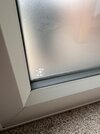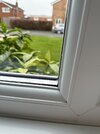Hi Everyone
I have a 1970s house which had new double glazing fitted I assume around 2007 however I can’t be sure as there is no evidence.
Every window in the house in the colder months suffers from condensation even when the room is adequately heated. It then generates black mould if not wiped away (which I do) but find it comes through the beading gaps regardless.
I always put this down to the house and it being airtight with no ventilation however last year I had a composite door fitted on the front to replace the old UPVC one (which also suffered terribly with condensation). This door made a massive difference to the hallway and in the year its been fitted has never had condensation or mould on any of the plastic.
Is it just a case of the windows aren’t good enough and require replacing for newer technology?
Photos attached showing landing window (wet), hallway door window (dry and in the same room) and the front room which is currently unheated as we don’t use that room (dry ish)
I would just like some guidance before splashing out on new windows all round. I would hate to do it and be in the same situation but something tells me I won’t.

I have a 1970s house which had new double glazing fitted I assume around 2007 however I can’t be sure as there is no evidence.
Every window in the house in the colder months suffers from condensation even when the room is adequately heated. It then generates black mould if not wiped away (which I do) but find it comes through the beading gaps regardless.
I always put this down to the house and it being airtight with no ventilation however last year I had a composite door fitted on the front to replace the old UPVC one (which also suffered terribly with condensation). This door made a massive difference to the hallway and in the year its been fitted has never had condensation or mould on any of the plastic.
Is it just a case of the windows aren’t good enough and require replacing for newer technology?
Photos attached showing landing window (wet), hallway door window (dry and in the same room) and the front room which is currently unheated as we don’t use that room (dry ish)
I would just like some guidance before splashing out on new windows all round. I would hate to do it and be in the same situation but something tells me I won’t.



